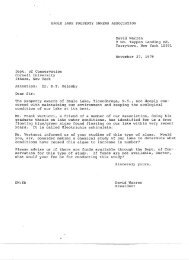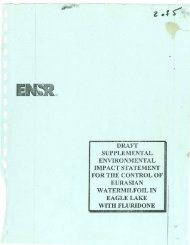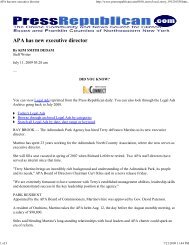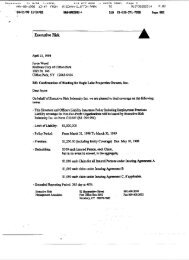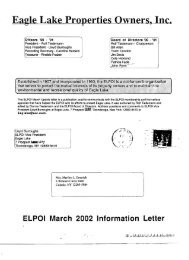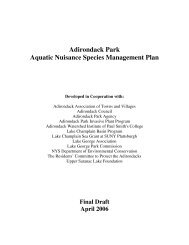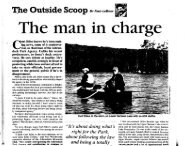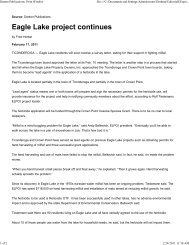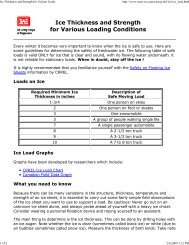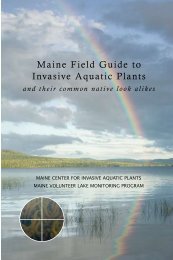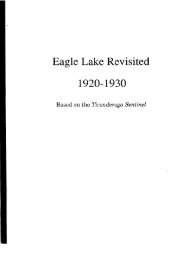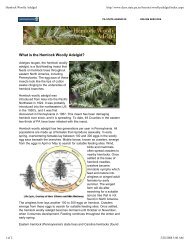Lake Hortonia 2008 - Eagle Lake Property Owner's Inc.
Lake Hortonia 2008 - Eagle Lake Property Owner's Inc.
Lake Hortonia 2008 - Eagle Lake Property Owner's Inc.
You also want an ePaper? Increase the reach of your titles
YUMPU automatically turns print PDFs into web optimized ePapers that Google loves.
Seventy percent of whole lake sampling points were vegetated by at least one native plant<br />
species (Figure 4), 90% of survey points with depths less than 4 m (Figure 5) and 100% of<br />
survey points less than 2 meters depth yielded native aquatic plants. Eurasian watermilfoil was<br />
present in 52% of whole lake survey points, and 62% of survey points less than 4 m water depth,<br />
representing the littoral zone or zone of aquatic plant growth. Native species frequency on a<br />
whole lake basis has remained relatively stable over the 9 surveys at from 48 to 70% of survey<br />
points for all water depths. Eurasian watermilfoil frequency of occurrence declined rapidly<br />
between 1999 (57%) and 2001 (9%) as a result of herbicide application prior to the 2000 survey.<br />
However, by 2003 frequency of occurrence had returned to near 1999 levels (49%). In 2004,<br />
during the year of treatment, Eurasian watermilfoil frequency of occurrence once again declined<br />
(29%). This decline continued into 2005, one year post treatment, with a Eurasian watermilfoil<br />
frequency of occurrence of 22%. Spot treatments in 2006 further reduced Eurasian watermilfoil<br />
frequency of occurrence to 4%. With no treatment in 2007 and <strong>2008</strong>, Eurasian watermilfoil<br />
frequency of occurrence once again increased (23% and 52%, respectively). Total plant<br />
frequency of occurrence reflects the decline in Eurasian watermilfoil growth between 1999 and<br />
2001 following herbicide application. An increase in total plant frequency of occurrence was<br />
observed between 2001 and 2003, with this increase continuing in 2004. Total plant frequency<br />
of occurrence has remained stable from 2005 through 2007 (Figure 4), even though a additional<br />
herbicide treatments occurred in 2004 and 2006. A slight increase in overall frequency of<br />
occurrence was observed in <strong>2008</strong>.<br />
120<br />
100<br />
1999 2000 2001 2003 2004 2005 2006 2007 <strong>2008</strong><br />
Percent Occurrence<br />
80<br />
60<br />
40<br />
20<br />
0<br />
Natives Milfoil Total<br />
Figure 5. Burr Pond frequency of occurrence summaries<br />
for sampling points less than 4 meters water depth.<br />
For survey points within the littoral zone, water depth less than 4 m (Figure 5), results similar to<br />
whole lake surveys are reported. The expected relationship of greater frequency of occurrence of<br />
aquatic plants with shallower water depth is consistent with that reported by Getsinger et al.<br />
(2002), where frequency of occurrence values in the littoral zone ranged from 78 to 87% of<br />
survey points. As with whole lake survey points, Eurasian watermilfoil frequency of occurrence<br />
10



